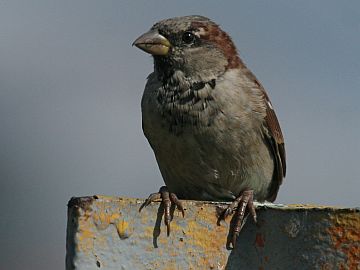
On Throw Back Thursday:
Last weekend was so cold that I watched outdoor birds while I sat indoors. But sometimes the wild birds and I are both in the building!
Back in February 2009 I saw birds in the grocery store. Click here to read more.

On Throw Back Thursday:
Last weekend was so cold that I watched outdoor birds while I sat indoors. But sometimes the wild birds and I are both in the building!
Back in February 2009 I saw birds in the grocery store. Click here to read more.

The phrase “The First Robin of Spring” is misleading. We think it means that robins leave for the winter. Not so in Pittsburgh. We always have robins in December.
American robins (Turdus migratorius) are very versatile birds. They change their diet for the season, eating invertebrates in summer and fruit in winter. They take advantage of invasive species, especially earthworms and bush honeysuckle. They move quickly to places where we’ve changed the landscape, adopting our farms and suburbs. And they’re flexible on migration.
Studies have shown that American robins migrate an average of 300-750 miles but that average doesn’t tell the whole story. Some flocks head directly south, arriving in Florida by early December. Others take their time, pausing when they find abundant food along the way. Still others stay home or travel less than 60 miles from their breeding grounds especially in the last two decades as the climate warms.
Every December, huge flocks of robins feed and roost in Allegheny County. In 2008 Scott Kinsey discovered 100,000 of them roosting in Carnegie. The flocks stay through the month and are counted on the Christmas Bird Counts. Then, when the fruit is gone, the ground freezes, or there’s snow cover the robins move on.
In Pittsburgh they normally don’t leave until January.
(photo by Chuck Tague)

17 November 2015
The juncos are back in town and even if they don’t look exactly alike I can assure you they’re all dark-eyed juncos.
This wasn’t always the case. When I was young there were seven species of juncos: white-winged, Oregon, slate-colored, gray-headed, Guadalupe, Mexican and Baird’s. In Pittsburgh we normally saw slate-colored juncos and were very excited when an Oregon junco showed up.
Then in 1983 the American Ornithological Union (AOU) determined that despite plumage differences there are really only two species: dark-eyed junco (Junco hyemalis) and yellow-eyed junco (Junco phaeonotus). All the plumage colors are members of the 15 +/- subspecies.
Dark eyed juncos range from Alaska and Canada down to Mexico. Yellow-eyed juncos are found only in Mexico, southern Arizona and southern New Mexico.
Here’s a bird in New Mexico with dark eyes that used to be the “Oregon junco” species.
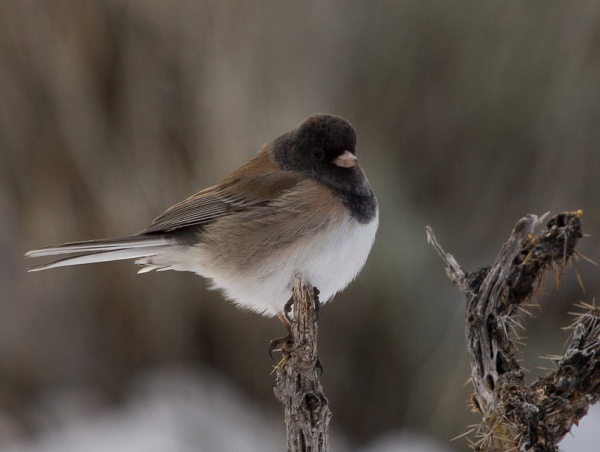
And here’s a yellow-eyed junco in Tucson.

So when you see an odd-looking junco don’t worry that his feathers don’t match the other birds. Check his eyes. Eye color is all that matters when parsing the two species of juncos.
UPDATE in 2022: However …! If you can identify junco subspecies it’s a thrill to find one out of its normal range or a hybrid such as the slate-colored/cismontanus junco that David Yeany found in February 2022. Here’s a February 2022 eBird checklist by Amy Henrici that includes photos of that bird.
(photos of dark-eyed juncos by Cris Hamilton and Steve Valasek. photo of yellow-eyed junco from Wikimedia Commons; click on the image to see the original)
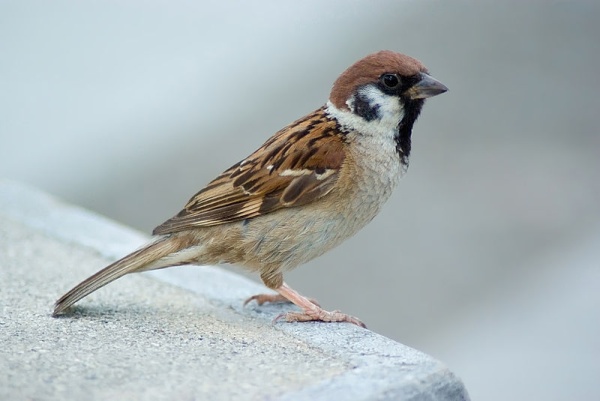
Names are so confusing!
This bird looks like a house sparrow (Passer domesticus) but he’s not. He’s a Eurasian tree sparrow and he’s the reason why our tree sparrows are called American tree sparrows.
Eurasian tree sparrows (Passer montanus) are native to Europe and Asia (of course) but about 15,000 of them live in the St. Louis area now. In the 1870’s, 12 were imported from Germany and established a breeding population but they were never as successful as their aggressive cousins.
Passer montanus is 10% smaller than a house sparrow, has a brown (not gray) head, and a black ear patch. Males and females look alike and the juveniles are just duller versions of the same.
Eurasian tree sparrows are doubly misnamed. They nest in holes in buildings, not in trees, and they don’t live in the mountains but they have “tree” and “montanus” in their names. That’s because house sparrows dominate the cities of Europe and pushed this sparrow to live in the open countryside where there are trees. In Asia the “tree” sparrow lives in cities.
American tree sparrows are misnamed, too. European settlers thought Spizella arborea resembled the Eurasian tree sparrow so they called ours “American tree sparrows” even though ours spend the winter in scrubby places, not trees, and breed and forage on the ground.
Do you think the American tree sparrow below looks like the Eurasian one above? I don’t.
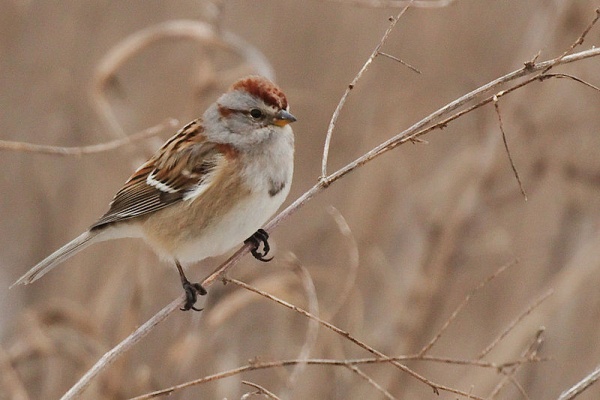
Alas, they are all misnamed.
(photos from Wikimedia Commons. Click on the images to see the originals)

In the past few weeks winter sparrows have arrived in western Pennsylvania. We’ve seen dark-eyed juncos, white-throated, white-crowned, and fox sparrows … but I haven’t heard of American tree sparrows yet.
American tree sparrows (Spizella arborea) breed in Canada and Alaska and spend the winter in weedy snow-covered fields and backyards in the Lower 48 states, though not as far south as Florida.
When they do show up they can be confusing. They resemble chipping sparrows except for a black dot in the center of their chests and a two-tone bill. (Notice the yellow lower mandible and the dull brown upper mandible.) The two don’t mix though. Chipping sparrows are usually gone by the time the tree sparrows get here.
Watch for the arrival of this same-but-different bird.
Have you seen an American tree sparrow yet?
(photo from Wikimedia Commons. Click on the image to see the original)

In Pittsburgh we don’t have sandpipers but in the winter we have something similar. Can we call them “land-pipers?”
Click here for a Throw Back Thursday article from 2008 about our substitute for shorebirds: Land-pipers.
UPDATE: Richard Nugent suggests they be called “lawn-pipers.” Excellent name!
(photo by “Mr. T in DC”, via Flickr, Creative Commons license. Click on the image to see the original.)
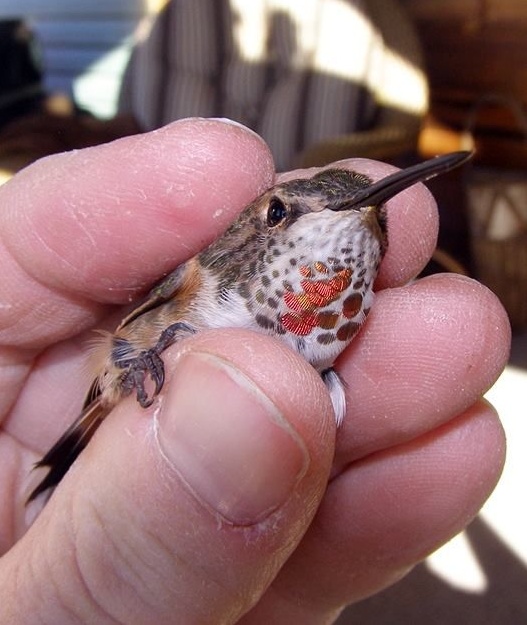
27 October 2015
Do you still have red flowers in your garden? Are your hummingbird feeders filled and clean? If so you might attract a rare bird.
Our ruby-throated hummingbirds (Archilochus colubris) have left for the tropics but a few hardy northwesterners visit Pennsylvania in the fall. They’re the Selasphorus hummingbirds.
The most likely visitors are rufous hummingbirds (Selasphorus rufus) that breed in the Pacific Northwest and as far north as Alaska. They’re used to cool temperatures and not bothered by our weather as long as they find enough to eat. During migration they range far and wide and often visit backyard feeders.
Solo birds can show up anywhere. Last year Hannah Floyd found one inside Phipps Conservatory during the 2014 Pittsburgh Christmas Bird Count. That female rufous wasn’t seen entering Phipps through an open window in October, but she was noticed when she hung out at the red powderpuff tree (Calliandra haematocephala) in the Stove Room.
Selasphorus hummingbirds are so rare in Pennsylvania that ornithologists work hard to band every one that’s found. Usually they’re identified as rufous hummingbirds but the species is so similar to the even-rarer-in-Pennsylvania Allen’s hummingbird (Selasphorus sasin) that the bird usually has to be in hand to tell.
If you see a hummingbird in your garden after mid-October, it’s rare! Call the National Aviary’s ornithologist Bob Mulvihill right away at 412-522-5729 (cell) or email him at robert.mulvihill@aviary.org or contact him via Facebook. He’ll stop by to capture and band it and you’ll get a chance to see it up close. He banded the female rufous pictured above in Carrolton, Pennsylvania on 19 October 2015.
To learn more about rare fall hummingbirds in western Pennsylvania at the National Aviary’s website: Winter Hummingbirds.
p.s. While you’re waiting for a rarity, watch hummingbirds spending the winter in West Texas on Cornell Lab’s West Texas Hummingbird Cam.
(photo by Bob Mulvihill)

In the normal progression of fall migration, October is when northern sparrows arrive in the Pittsburgh area.
I’ve already seen my first white-throated and white-crowned sparrows, but I haven’t seen a dark-eyed junco yet.
Some people call juncoes “snowbirds” because they arrive with the first snow. Fortunately our juncoes get here before that happens.
I’m waiting for snowbirds, but not for snow.
(photo by Cris Hamilton)
UPDATE: First junco in my yard this fall appeared on Oct 29 after the rain. Then a pause and today (Oct 31) I have 2 juncoes.

Throw Back Thursday (TBT):
In the weeks ahead ducks and geese will migrate through Pennsylvania from the frozen north.
We intuitively separate ducks and geese into two classes of waterfowl — “This one’s a duck, that one’s a goose” — but how?
Three years ago I mused about this question and got a surprising answer when I asked “What’s the difference between a duck and a goose?”
Click here to find out.
(silhouette images: duck from Freedigitaldownloads, goose from Shutterstock)
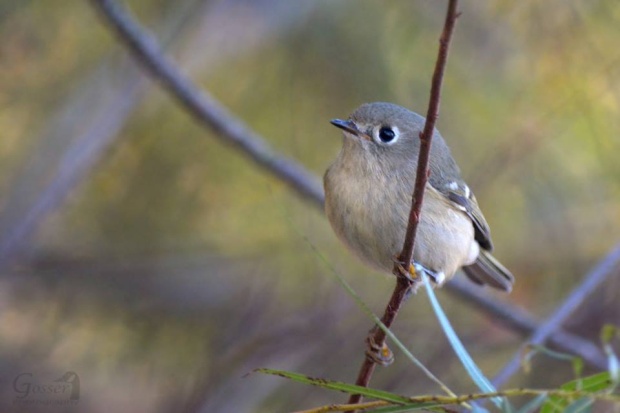
You can’t tell the difference between male and female ruby-crowned kinglets (Regulus calendula) unless they’re upset. Only males have the ruby crown that gave the bird its name but they hide it unless they’re agitated.
Fortunately for us, ruby-crowned kinglets are feisty and will raise their head feathers as a challenge to each other and just about anyone else.
Watch for them migrating through western Pennsylvania this month.
Steve Gosser photographed this one at Shenango Lake, Mercer County.
(photo by Steve Gosser)